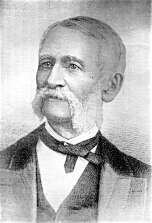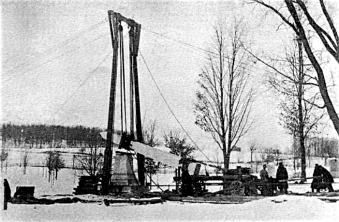|
We’ve Been Asked: Who Was John L. Lewis and How Did He Get Such a HUGE Monument?
Yates Past - November 2008
If you were to drive into the Elm Street entrance to Lakeview Cemetery in Penn Yan, you can’t miss it. It’s dead ahead of you (pardon the play on words) in a place of honor looking like a smaller version of the Washington Monument. Technically, it’s an obelisk as tall as a three-story building and on its base is inscribed “John L. Lewis 1813-1889”. Who was John L. Lewis? To begin with, if you are an American history buff, this is not THE John L. Lewis, he of the bushy eyebrows who founded the United Mine Workers of America. Yates County’s John L. Lewis lived earlier. He was a big fish but in a much smaller pond.
Our John L. Lewis was born in what today would be the Town of Torrey in Yates County before either the county or the town was formed. His father was a Yale graduate who was hired to teach in Benton Center in 1802 and later started his own school on what today would be Flat Street just north of Penn Yan. As a young man, John studied law with William Oliver in Penn Yan. (There is a real Oliver House connection here. William Oliver was the brother of Andrew Oliver who built the house for his son in 1852. Lewis later married Andrew Oliver’s daughter, Jane. John and Jane Lewis lived in her father’s house after he died, just two houses away from the Oliver House.). He was admitted to the New York Bar in 1835 and then his legal career advanced rapidly; Justice of the Peace, District Attorney, and then County Judge and Surrogate. He was allowed to argue before the U.S. Supreme Court and was elected to the New York State Board of Regents.
 D.D. Turner, who wrote a short biographical sketch of John L. Lewis in 1900, wrote: “Mr. Lewis was greatly interested in all educational matters and gathered many historical facts, which afterwards found their way into public print, for the edification of the students of the county. He was also well informed in the Indian vocabulary of the Senecas. He was a diligent student of all languages as well and informed the writer of this biography that he had gained a speaking knowledge of ten languages by studying and translating them from almanacs.” D.D. Turner, who wrote a short biographical sketch of John L. Lewis in 1900, wrote: “Mr. Lewis was greatly interested in all educational matters and gathered many historical facts, which afterwards found their way into public print, for the edification of the students of the county. He was also well informed in the Indian vocabulary of the Senecas. He was a diligent student of all languages as well and informed the writer of this biography that he had gained a speaking knowledge of ten languages by studying and translating them from almanacs.”
It was as a member of the Milo Lodge of the Masons that John Lewis really made his mark. He was active in the Masons from 1846 until his death in 1889. He rose from leading the local lodge to be the head of the state organization (Grand Master of the Grand Lodge of the State of New York). He also served high office in the national organization and gained the highest rank possible in Scottish Rite Freemasonry, the 33rd Degree. He was chosen by the Grand Lodges of England, Scotland, and wales to be their representative in this country.
He died in his home on Main Street in Penn Yan in June of 1889. The funeral was held in the Presbyterian Church and it was filled to overflowing as Masons from all over this part of the country attended. In the pouring rain, the huge crowd accompanied the remains of John L. Lewis to Lakeview Cemetery where he was laid to rest beneath a simple headstone in a family plot next to his wife and two sons.
For years the Milo Lodge of the Masons talked about erecting a suitable monument to the man who went so far in their organization, but they lacked the finances. In 1898, they decided to appeal to the Grand Lodge of New York for the funds and that state organization decided to donate $500. $1500 more was raised from other Lodges and a statewide committee was appointed to decide from twenty designs for the monument that had been submitted. They chose the obelisk because that was the design that John Lewis had picked for others. The eight foot square base was finished in September of 1899. The 33-foot shaft (symbolizing the 33rd Degree rank) was quarried in Barre, Vermont and shipped to Penn Yan where it arrived in December of that year. It weighed forty tons and took five teams of horses to pull it from the New York Central depot in Penn Yan to the cemetery where it was placed on the base. The dedication ceremony was held in October of 1902 when nearly three hundred Masons from around the country marched from the Masonic Lodge on Jacob Street to the cemetery where a special platform was constructed for the high ranking officials facing the monument. A lengthy oration on the life of John L. Lewis was made by the Grand Master of the State of New York and was the high point of the two-hour ceremony.
by Rich MacAlpine

|
